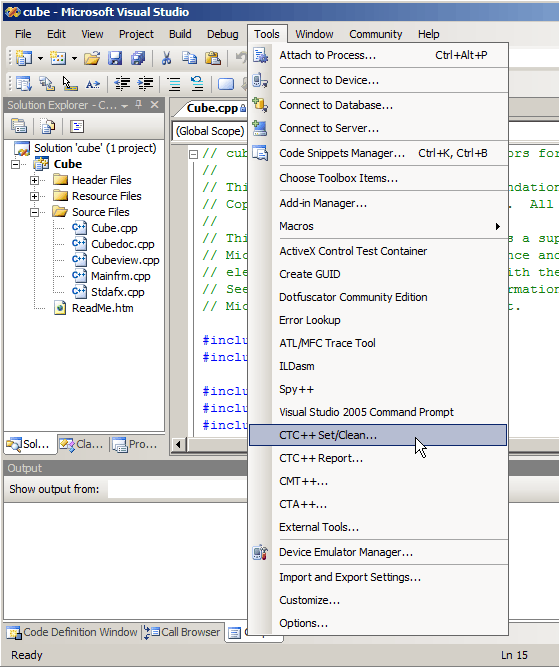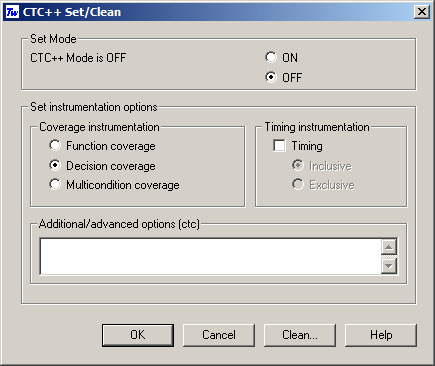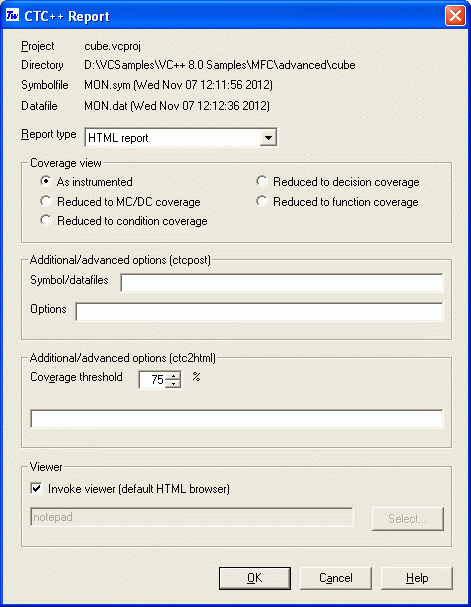CTC++ Integration to Visual Studio
Here our context is Windows. With "Visual Studio"
we mean Visual Studio 2003 or later. See below a remark of
usage with Visual
Studio 6.0.
When the
program files are in Visual Studio framework, they can be built
from graphical IDE or from command line by 'devenv', 'vcbuild'
or 'msbuild' commands. Making the command-line builds as
"ctc-builds" is simple. Just prepend the command with "ctcwrap
ctc-options", something like the following:
ctcwrap -i m -v devenv mysolution.sln /rebuild debug
or
ctcwrap -i dti vcbuild /rebuild myproject.vcproj Debug
or
ctcwrap -i f msbuild myproj.vcproj /t:Rebuild /p:Configuration=Debug

To begin with,
you select CTC++ Set/Clean... command, which brings you to the
following dialog:

You set the CTC++ Mode ON and
select the instrumentation options as needed and click "OK".
From now on, when you compile the
code by Visual Studio Build > (Re)Build commands , the
compilations are "ctc-compilations". As result you get instrumented
application (normally an .EXE or .DLL).
Then you run the program
normally. You can start it from Visual Studio or outside of it. The
program execution collects the coverage data and writes/appends it
to the datafile.
You get the the coverage reports
by Tools > CTC++ Report... command. It is a dialog program
looking as follows:

In the "Report type" pull-down
menu you get alternatives to take the following reports:
-
HTML report: First a textual
report is taken by ctcpost tool to a file. It is then inputted to
the ctc2html tool, which converts it to hierarchical color-coded
form. Your PC's default browser is started on the HTML report
(unless you have denied it).
Untested report to Visual
Studio: First a textual Untested Code Listing is taken to a file.
Then it is written to Visual Studio output window so that each
line is prefixed with "sourcefilename(linenumber):". Clicking on
on such line brings to the source window the source file and
positions the cursor at the corresponding line. This is a
convenient way to see the untested code locations.
-
Profile listing (textual):
With ctcpost tool an Execution Profile Listing is generated to a
file. Then a viewer (notepad by default) is started on it (unless
you have denied it).
Timing listing (textual):
With ctcpost tool an Execution Time Listing is generated to a
file. Then a viewer (notepad by default) is started on it (unless
you have denied it).
-
XML report: With ctcpost tool
an XML report is generated to a file. Then a viewer (notepad by
default) is started on it (unless you have denied it).
In "Coverage view" area you can
fine-tune how the coverage report will be generated. For example, if
the code has been instrumented for multicondition coverage, you can
get the report in a lower MC/DC coverage view.
When you want to get back
to the non-instrumented version of your program, in the
CTC++ Set/Clean... dialog you set CTC++ Mode OFF and rebuild your program.
When you want to get rid of all
CTC++ generated files from your project directory (symbolfile,
datafile, various report files), you can use the CTC++ Set/Clean...
command's subdialog CTC++ Clean... for doing it.
Usage with Visual Studio 6.0
Of course the usage is possible
with Microsoft VC++ 6.0 compiler from command line. For example with
makefiles, which emit cl and link commands.
If your code is in a Visual
Studio 6.0 IDE framework, the usage is possible as follows:
Export from the project its
makefile
Build the project by
'ctcwrap' and 'nmake', something like the following:
ctcwrap -i d nmake -f myproject.mak clean all
-
Run the tests normally with
the instrumented program
-
Take the reports with ctcpost
and ctc2html tools in command line mode